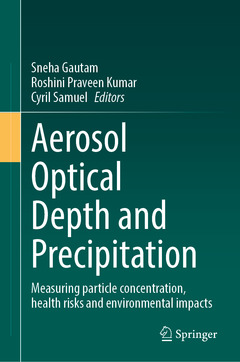Aerosol Optical Depth and Precipitation, 1st ed. 2024 Measuring particle concentration, health risks and environmental impacts
Coordonnateurs : Gautam Sneha, Kumar Roshini Praveen, Samuel Cyril

Dr. Sneha Gautam is an Associate Professor at the Department of Civil Engineering at Karunya Institute of Technology and Sciences, Coimbatore, India. He holds a Ph.D. in Engineering from the Indian Institute of Technology (IIT), Kharagpur, and an M.Tech in Environmental Science and Engineering from the Indian Institute of Technology, Indian School of Mines (IIT - ISM) Dhanbad. Following his Ph.D., Dr. Gautam has had a distinguished career. He worked at INCLEN and the University of California, Berkeley, USA, from May 2015 to July 2016. Subsequently, he received a Postdoctoral Fellowship from the Ministry of Science and Technology, Taiwan, and continued his postdoctoral work from August 2016 to May 2017. Later, he served as an Assistant Professor & Head at Marwadi University, Rajkot, Gujarat, from September 2017 to April 2019. Dr. Gautam's research is at the intersection of clean air engineering/science, human health, and smart/sustainable living in urban environments. His work delves into the formation and emission of particles, with a focus on both vehicular and non-vehicular sources, particularly in the context of megacities. His contributions extend to developing low-cost sensing approaches and aiding in the formulation of exposure control technology and guidelines for policymakers, leading to improved urban air quality and associated health benefits. Additionally, Dr. Gautam has served as an editor for various journals and has published papers in diverse multidisciplinary fields. His commitment to advancing knowledge and addressing environmental challenges is evident in his extensive contributions to academia and research
Roshini Praveen Kumar, a dedicated individual, completed her B.E. in Civil Engineering at VDIT-Haliyal in 2019. Subsequently, she pursued an M. Tech. in Environment and Water Resource at Karunya Institute of Technology and Sciences, Coimbatore, India,from 2019 to 2021. With a focus on aerosol retrieval studies
Date de parution : 06-2024
Ouvrage de 283 p.
15.5x23.5 cm



